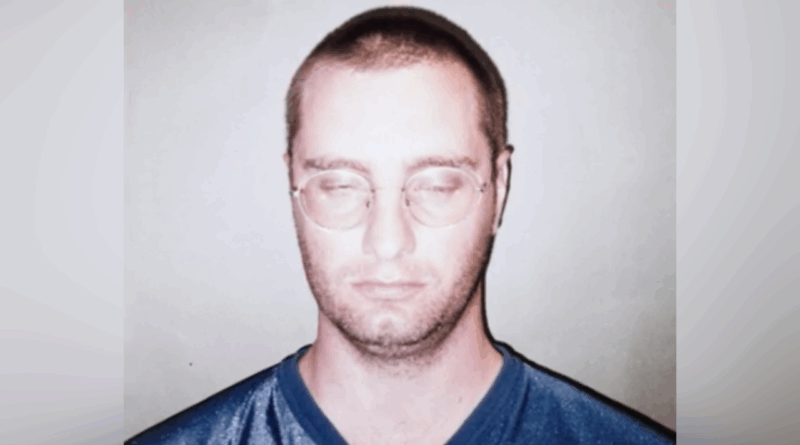Terry Todd Wedding Killed His Family After Being Forced into Psych Hospital in Greenville Kentucky
On June 27, 1999, a tight-knit corner of Muhlenberg County, Kentucky—anchored by the small city of Greenville and the nearby community of Depoy—was shaken by a quadruple homicide that would leave enduring scars on families, neighbors, and law enforcement. At the center was 27-year-old Terry Todd Wedding, ultimately held responsible for the killings of his parents, Beverly and Todd Wedding, and of his cousin, Joey T. Vincent, and Joey’s wife, Amy Vincent. The case was at once domestic, local, and profoundly destabilizing: violence erupting within a family that had deep roots in the area, unfolding across familiar roads and yards where people knew one another by first name. What happened on that Sunday became a reference point in local memory—an event people use to mark time, measure loss, and caution against ignoring the pressures that can build inside a family system until they explode.
Setting: Greenville, Depoy, and a Family With Local Roots
Muhlenberg County is the kind of place where connections run deep—church fellowships, school sports, and multi-generational ties tie people to place. Greenville is the county seat; Depoy, a nearby community, is smaller but no less interwoven. The Wedding and Vincent families had long-standing relationships in the area, and that shared history amplified the shock. The locations involved in the case were not random addresses on a map; they were homes where baby showers, backyard barbecues, and ordinary Sunday afternoons took place. That familiarity would make the crime scenes feel painfully intimate to residents and to the officers who responded.
The People at the Center
The victims—Beverly Wedding, her husband Todd Wedding, and the young couple Joey and Amy Vincent—were bound together by kinship and everyday interdependence. Beverly and Todd were Terry’s parents; Joey was Terry’s cousin. Amy, married to Joey, was part of a newer generation growing their own family. A detail that resonated deeply in the community was the presence of a small child who survived the violence physically unharmed—an unsettling juxtaposition of innocence and devastation that responders and extended family never forgot. The presence of that child would become a lingering symbol of what was lost and what would have to be rebuilt.
June 27, 1999: A Day Unspooling Into Tragedy
Weekend days in Muhlenberg County often follow predictable rhythms—errands, church, catching up with kin. The 27th of June began as many days did, with the comings and goings of relatives who lived close enough to visit without ceremony. Sometime that day, a chain of events unfolded that led from words to weapons, from familiar rooms and porches to emergency calls and a perimeter of police tape. The violence occurred at and around locations associated with the Wedding and Vincent households—spaces that had, until then, held the comforting clutter of family life.
However one reconstructs the timeline, the critical hinge is that the violence moved through kinship lines rather than across them: parents and cousins became victims; a son and a cousin became the accused. The sense of betrayal cut so deep partly because of that grammar of insider harm. For officers and neighbors, the first hours combined the urgency of an active investigation with the slow dawn of recognition—these were not strangers, and the unfolding facts involved people many of them knew by first name.
First Responders, First Impressions
Patrol units and investigators who reached the scenes were forced to split their attention among immediate safety, medical triage, and the preservation of evidence. In a rural county, multiple scenes can stretch resources thin—every step must be careful, every observation logged. What they confronted was the aftermath of lethal force within domestic spaces. The atmosphere that evening and into the night had the haunted, hyper-alert quality responders describe when shock and duty meet: neighbors congregating just beyond the tape, porch lights glowing, radios chattering with updates and requests.
Building the Case: From Shock to Structure
Even when a suspect is quickly identified, homicide investigations must proceed methodically. Detectives coordinated interviews with family members, neighbors, and anyone who had recent contact with the households. They documented entry points, ballistic or blunt-force evidence where relevant, and the position and condition of rooms that had only recently held normal family life. The challenge in domestic homicide inquiries is two-fold: establishing the sequence of actions inside familiar spaces and understanding the relational tensions that may have preceded them. Investigators focused on both timelines and relationships—who argued with whom, what pressures had been mounting, who tried to intervene, and when.
The Suspect: The Complicated Figure of the Family Son
A central complexity of the case was that the suspect, Terry Todd Wedding, was not an unknown threat but a family member whose biography was entwined with the victims’. That biographical closeness always complicates both public emotion and investigative analysis. In interviews, people tend to speak in the language of remembered kindnesses and long-simmering frustrations—“He used to,” “He could be,” “He had been struggling,” “We tried to help,” “We didn’t see this coming,” or “We worried something would happen.” These statements emerge not as legal conclusions but as fragments of shared biography. Investigators sift through them for patterns: recent conflicts, substance use, mental-health concerns, financial stressors, resentments about control, or escalating volatility.
Domestic Homicide Dynamics: Control, Identity, and Escalation
Family homicides often orbit recurring themes: the struggle for autonomy, conflicts over rules and expectations, identity crises in early adulthood, or the collision of untreated mental-health needs with household tensions. In extended families, cousins can function as peers, rivals, confidants, or all three. Parents anchor the system—supportive yet sometimes enforcing boundaries the adult child resents. When pressures mount, the home can shift from a space of care to a contested arena. Domestic violence specialists describe an escalation curve—arguments, threats, property damage, physical assaults—culminating in lethal violence if interventions fail or are resisted.
The Greenville case bore the hallmarks of such escalation. People close to the family had seen signs that trouble was brewing. The day’s lethal turning point, whether sparked by a specific confrontation or triggered by a cumulative boil-over, arrived when restabilizing forces—cooling-off periods, third-party mediation, or clinical intervention—did not intervene in time.
Law Enforcement Coordination Across Multiple Scenes
Once crime scenes were secured, the sheriff’s office and local police coordinated with state authorities. Crime-scene technicians documented every inch of relevant space: photographs, measurements, potential DNA traces, ballistic trajectories if firearms were involved, and the location of physical objects that might indicate a sequence of events. Separate scenes—home interiors, driveways, yards—had to be linked into a coherent narrative that could withstand courtroom scrutiny. In rural investigations, that means budgeting limited lab time carefully, transporting evidence under chain-of-custody protocols, and matching witness accounts against what the physical evidence could (and could not) confirm.
Arrest, Charging, and the Gravity of the Docket
With evidence converging on a single suspect, authorities moved to arrest and charge. The charges reflected the gravest category under Kentucky law—multiple counts of murder—and placed the case on a path toward either trial or a plea agreement. For the families of the victims, arraignments and pretrial hearings are grueling: on one side of the courtroom sits the accused, bearing the face and name of their own kin; on the other, rows of people mourning parents, cousins, a spouse, and the extinguished future of a young family. Prosecutors balanced the goals of accountability, community safety, and the certainty of outcome with the practical realities of evidence law and the trauma of trial.
Legal Resolution and Sentencing
The case resolved with a life sentence—a judicial acknowledgment of the severity of four murders within a single family system and the acute harm inflicted on the community. In a prosecution like this, sentencing allocutes not only to statutory factors (number of victims, nature of the acts, danger to the community) but also to the moral calculus of familial betrayal. Courts weigh aggravating features—multiple victims, vulnerability of victims inside their homes, the ripple effects on surviving children—against any mitigating claims. Here, the outcome reflected the profound damage done: four lives ended, a lineage shattered, and communal trust shaken.
The Surviving Child and the Weight of Aftermath
One of the case’s most wrenching elements was the survival of a small child amidst the violence. For social workers, guardians ad litem, and the family members who stepped in, the practical questions were immediate—custody, counseling, the logistics of daily life—while the existential questions would stretch across years. How do you tell the story of what happened in a way that protects a child’s dignity? How does a community scaffold that child’s growth with steadiness and love, even as adults struggle with their own grief? Survivors’ advocates emphasize the importance of stable placement, trauma-informed counseling, and a circle of adults who can share the burden of memory without making it the child’s task to carry alone.
Grief in Small Communities: Public Mourning, Private Pain
In large cities, homicides can recede into statistics. In places like Greenville and Depoy, they leave hollows where people’s lives used to be and echo in everyday routines. Church congregations hold vigils; workplaces circulate donation envelopes; neighbors cook casseroles and mow lawns unasked. The rituals of grief become community work. That summer, front porches and parking lots became informal counseling rooms. People spoke softly at grocery stores. A child’s toy left on a stoop could stop someone in their tracks. The losses were not abstractions but the absence of four specific people from holidays, reunions, and Sunday dinners.
The Role of Media and the Narrative We Tell
Local and regional media covered the case with the sober intensity it demanded. Over time, the case also drew attention from true-crime chroniclers who try to make sense of the incomprehensible. Those secondary narratives can be useful for memory—collecting dates, names, and legal outcomes—but they can also over-tidy real human complexity. The danger in any retelling is the flattening of individuals into archetypes: “the troubled son,” “the young couple,” “the brave responders.” The reality is messier and more human. Beverly and Todd were more than their last day; Joey and Amy were building a life that had texture and plans. Those who responded, investigated, and prosecuted were neighbors as well as professionals.
Motives, Mental Health, and the Limits of Explanation
In family mass homicides, there is intense pressure to name the motive: mental health crises, substance misuse, financial desperation, anger at perceived slights, jealousy, control. Sometimes one factor predominates; more often, several contribute. Friends and relatives may recall erratic behavior or pleas for help that did not lead to sustained care. Others may remember stretches of ordinary calm. What remains after the paperwork is the unsatisfying truth that no single sentence fully explains how a son kills his parents or why a family quarrel expands into lethal territory. Investigators and clinicians agree on one hard lesson: prevention lives earlier in the timeline—in treatment access, boundary-setting, de-escalation training, safe-storage practices, and the willingness to intervene even when it risks conflict.
Law Enforcement Lessons: Interagency Practice and Trauma Care
The case reinforced a number of practical lessons for rural policing. First, the value of mutual aid agreements: when multiple scenes unfold at once, agency-to-agency cooperation is the difference between chaos and method. Second, the importance of trauma-informed practice for responders themselves. Scenes involving murdered parents and a young couple can leave lasting imprints on officers, medics, and dispatchers. Formal debriefs and access to confidential counseling are not luxuries; they are occupational safety measures. Third, evidence discipline—especially when the suspect is quickly identified—remains vital. The integrity of a case rests not only on who likely did it but on how thoroughly the state can prove it.
Community Safety After a Domestic Catastrophe
When a suspect is in custody and a sentence is imposed, a community slowly begins the work of recalibrating its sense of safety. Counselors visit schools, clergy meet with families, and barbershops and diners become informal forums for processing shared trauma. In the domestic violence field, education campaigns often follow high-profile cases: hotlines, shelter resources, and training for recognizing warning signs. The Greenville case was not about a stranger stalking the streets; it was about risks that can hide in plain sight inside homes. Safety after such a case does not mean fear of the outsider; it means cultivating the courage to speak up when something feels wrong among our own.
Memory, Memorials, and What Endures
In the years since 1999, family and friends have honored Beverly, Todd, Joey, and Amy in ways large and small—photos on mantels, small stones at graves, family stories told to children born later. Those acts of remembrance do not merely look backward; they carry forward the best of who these four people were: parents, spouses, relatives, neighbors. When anniversaries arrive each June, the ache returns, but so do the rituals that help communities endure: gatherings, quiet visits, acts of service in their names. Memory, in this sense, is a form of care.
Why This Case Still Matters
The Greenville killings compel attention not because they are sensational but because they illuminate a universal fault line: the places where family, stress, identity, and untreated crises intersect. They remind us that prevention is not abstract—it is a neighbor offering a couch for a cooling-off night, a parent insisting on counseling even when it sparks an argument, a clinician making one more follow-up call, a family locking away firearms during periods of instability, a congregation creating a confidential pathway to help. Systems matter, but so do individuals who choose to act before a hard day turns catastrophic.
A Cautious Conclusion
No narrative gives back what was taken on June 27, 1999. The legal resolution delivered accountability, but not restoration. What the Greenville community has modeled, however, is the long work of tending to the living—especially to the child who survived, to siblings and cousins who carry complicated grief, and to first responders who shouldered both duty and sorrow. The measure of a place is not whether tragedy visits—it eventually does—but whether people meet it together. By that measure, the families and neighbors around Greenville and Depoy have shown a stubborn, necessary courage.
Discover more from City Towner
Subscribe to get the latest posts sent to your email.




